 y.layout.CanonicMultiStageLayouter
y.layout.CanonicMultiStageLayouter
 y.layout.seriesparallel.SeriesParallelLayouter
y.layout.seriesparallel.SeriesParallelLayouter
|
Search this API | ||||||||
| PREV CLASS NEXT CLASS | FRAMES NO FRAMES | ||||||||
| SUMMARY: NESTED | FIELD | CONSTR | METHOD | DETAIL: FIELD | CONSTR | METHOD | ||||||||
java.lang.Objecty.layout.CanonicMultiStageLayouter
y.layout.seriesparallel.SeriesParallelLayouter
public class SeriesParallelLayouter
This layout algorithm arranges series-parallel graphs.
Series-parallel graphs are directed graphs with a single source (node without incoming edges) and a single sink (node without outgoing edges). The layout algorithm highlights the main layout direction (from source to sink). It also emphasizes the paths through the graph because edges are routed with few bends.
SeriesParallelLayouter is suitable for the visualization of circuits, call trees or flowcharts.
Series-parallel graphs are directed graphs with a single source (node without incoming edges) and a single sink (node without outgoing edges) that are built using only the following two rules:
From the recursive structure of series-parallel graphs, the layout algorithm retrieves a decomposition tree where each
node represents one of the decomposition types. Then, this tree is traversed recursively from bottom to top, aligning
subgraphs above (series) or next to (parallel) each other until the whole graph is arranged. The edges are routed
when both end nodes are placed. Different routing styles can be used.
To avoid moving all nodes several times and to be aware of the area that the subtrees occupy, the layout algorithm keeps track of the shape of the subtrees. These shapes are moved and merged during the layout calculation. The layout algorithm also stores the connections between nodes and nodes that haven't already been placed in these shapes.
SeriesParallelLayouter can take strong PortConstraints into account. It will connect the
edges to the specified locations, the directions, however, will be ignored.
Grouping of nodes can also be handled by this layout algorithm. It is important that a group node contains a whole
series-parallel subgraph. Otherwise, the group nodes may overlap with each other or with other nodes. Edges which
are connected to non-empty group nodes are not allowed. Furthermore, the user may specify minimum size constraints
for each group node using DataProvider key GroupingKeys.MINIMUM_NODE_SIZE_DPKEY.
The layout algorithm can be configured to reserve space for node labels and to place the edge labels along the edge
such that the labels won't overlap with other graph elements. Edge labels are placed according to the information
stored in a PreferredPlacementDescriptor instance. However, labels that should be centered between source
and target are placed close to the target node, unless this edge connects to the local source and sink of a subgraph.
Parallel subgraphs can be aligned in different ways. Depending on the node sizes, a different alignment can increase the compactness of the layout.
The way in which edges are distributed around their incident nodes is computed by an instance of
PortAssignment. The default assignment is able to consider
PortConstraints and edge groups.
The From Sketch mode allows to take the initial locations of the nodes
into account. However, the layout algorithm won't insert crossings because it maintains the order of children of
each node.
SeriesParallelLayouter supports custom sorting of the outgoing edges of a node. A Comparator can be
assigned individually for the nodes using a DataProvider registered with key
OUT_EDGE_COMPARATOR_DPKEY. For all nodes for which the DataProvider returns null, the
layout algorithm falls back to the default comparator.
By default, this layout algorithm can only handle graphs with a series-parallel structure. To apply it to a general
graph, general graph handling needs to be activated. Then, the
layout algorithm will temporarily add and/or remove some edges from the input graph until a series-parallel graph is
obtained. The edges that were removed will be routed separately afterwards.
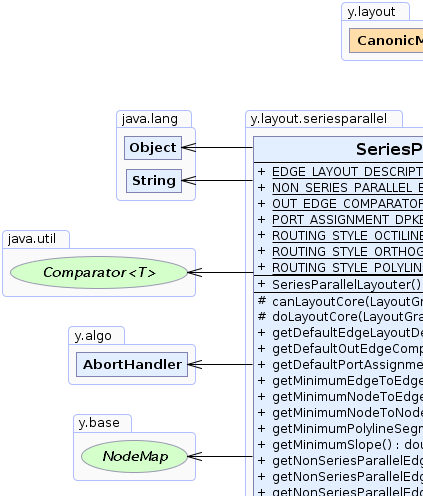 |
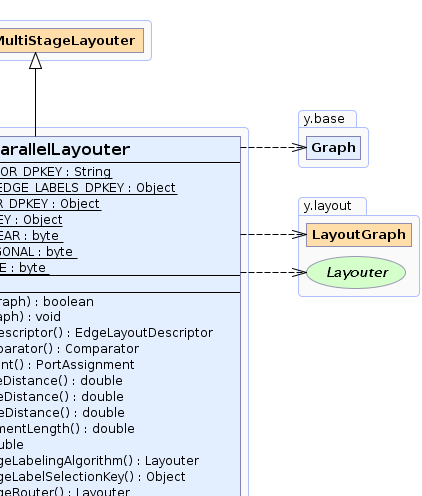 |
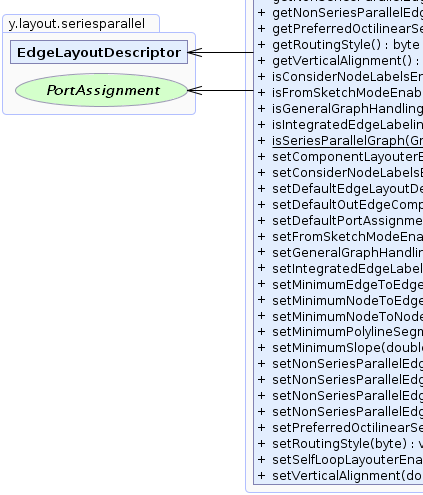 |
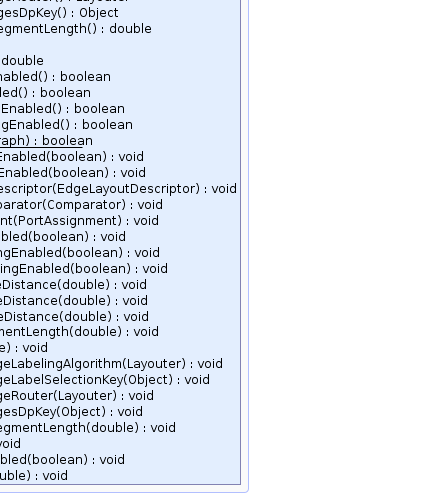 |
| Field Summary | |
|---|---|
static java.lang.String |
EDGE_LAYOUT_DESCRIPTOR_DPKEY
A DataProvider key for storing individual settings for edges
If no edge layout descriptor is mapped for an edge, a default edge layout descriptor will be obtained by method
getDefaultEdgeLayoutDescriptor(). |
static java.lang.Object |
NON_SERIES_PARALLEL_EDGE_LABELS_DPKEY
A DataProvider key for marking edge labels of non-series-parallel edges
|
static java.lang.Object |
OUT_EDGE_COMPARATOR_DPKEY
A DataProvider key for assigning different orderings for outgoing edges of the nodes
If the Comparator associated with a node is null, the outgoing edges maintain their
initial order. |
static java.lang.Object |
PORT_ASSIGNMENT_DPKEY
A DataProvider key for providing an individual port distribution at nodes
If there is no PortAssignment specified for a node, the layout algorithm uses the
default assignment. |
static byte |
ROUTING_STYLE_OCTILINEAR
Style constant describing an octilinear edge style. |
static byte |
ROUTING_STYLE_ORTHOGONAL
Style constant describing an orthogonal edge style. |
static byte |
ROUTING_STYLE_POLYLINE
Style constant describing a polyline edge style. |
| Fields inherited from interface y.layout.Layouter |
|---|
EDGE_ID_DPKEY, NODE_ID_DPKEY, NODE_TYPE_DPKEY, SELECTED_EDGES, SELECTED_NODES |
| Constructor Summary | |
|---|---|
SeriesParallelLayouter()
Creates a new SeriesParallelLayouter instance with default settings. |
|
| Method Summary | |
|---|---|
protected boolean |
canLayoutCore(LayoutGraph graph)
Checks whether or not the given graph is series-parallel and can be arranged by this layout algorithm. |
protected void |
doLayoutCore(LayoutGraph graph)
Calculates a series-parallel layout for the given graph. |
EdgeLayoutDescriptor |
getDefaultEdgeLayoutDescriptor()
Returns the EdgeLayoutDescriptor instance used for all those edges that do not have a specific layout
descriptor assigned. |
java.util.Comparator |
getDefaultOutEdgeComparator()
Returns the default Comparator used for sorting the outgoing edges incident to nodes that do not have a
specific Comparator. |
PortAssignment |
getDefaultPortAssignment()
Returns the default PortAssignment used for those nodes that do not have their own specific instance. |
double |
getMinimumEdgeToEdgeDistance()
Returns the minimum distance between edges. |
double |
getMinimumNodeToEdgeDistance()
Returns the minimum distance between nodes and edges. |
double |
getMinimumNodeToNodeDistance()
Returns the minimum distance between nodes. |
double |
getMinimumPolylineSegmentLength()
Returns the minimum vertical distance of the edge segments that are not orthogonal. |
double |
getMinimumSlope()
Returns the minimum slope which a non-orthogonal edge segment should have. |
Layouter |
getNonSeriesParallelEdgeLabelingAlgorithm()
Returns the labeling algorithm that is applied to all edge labels that belong to non-series-parallel edges. |
java.lang.Object |
getNonSeriesParallelEdgeLabelSelectionKey()
Returns the key to register a DataProvider that is used by the
non-series-parallel edge labeling algorithm to determine
which edge labels it should place. |
Layouter |
getNonSeriesParallelEdgeRouter()
Returns the edge routing algorithm used for the edges of a general graph that are not part of the series-parallel subgraph whose layout is calculated. |
java.lang.Object |
getNonSeriesParallelEdgesDpKey()
Returns the key to register a DataProvider that is used for marking non-series-parallel edges. |
double |
getPreferredOctilinearSegmentLength()
Returns the preferred length for non-orthogonal segments in octilinear edge routes. |
byte |
getRoutingStyle()
Returns the currently used routing style for edges. |
double |
getVerticalAlignment()
Returns the vertical alignment of parallel subgraphs. |
boolean |
isConsiderNodeLabelsEnabled()
Returns whether or not the layout algorithm reserves space for node labels to avoid overlaps. |
boolean |
isFromSketchModeEnabled()
Returns whether or not to take the coordinates of the input diagram into account when arranging the nodes. |
boolean |
isGeneralGraphHandlingEnabled()
Returns whether or not the layout algorithm can handle general graphs. |
boolean |
isIntegratedEdgeLabelingEnabled()
Returns whether or not the layout algorithm will place edge labels and reserve space for them. |
static boolean |
isSeriesParallelGraph(Graph graph)
Determines whether or not the given graph has a series-parallel structure. |
void |
setComponentLayouterEnabled(boolean enabled)
Specifies whether or not the LayoutStage used for arranging the components of the graph is activated. |
void |
setConsiderNodeLabelsEnabled(boolean enabled)
Specifies whether or not the layout algorithm reserves space for node labels to avoid overlaps. |
void |
setDefaultEdgeLayoutDescriptor(EdgeLayoutDescriptor descriptor)
Specifies the EdgeLayoutDescriptor instance used for all those edges that do not have a specific layout
descriptor assigned. |
void |
setDefaultOutEdgeComparator(java.util.Comparator defaultOutEdgeComparator)
Specifies the default Comparator used for sorting the outgoing edges incident to nodes that do not have a
specific Comparator. |
void |
setDefaultPortAssignment(PortAssignment defaultPortAssignment)
Specifies the default PortAssignment used for those nodes that do not have their own specific instance. |
void |
setFromSketchModeEnabled(boolean fromSketchModeEnabled)
Specifies whether or not to take the coordinates of the input diagram into account when arranging the nodes. |
void |
setGeneralGraphHandlingEnabled(boolean enabled)
Specifies whether or not the layout algorithm can handle general graphs. |
void |
setIntegratedEdgeLabelingEnabled(boolean enabled)
Specifies whether or not the layout algorithm will place edge labels and reserve space for them. |
void |
setMinimumEdgeToEdgeDistance(double minimumEdgeToEdgeDistance)
Specifies the minimum distance between edges. |
void |
setMinimumNodeToEdgeDistance(double minimumNodeToEdgeDistance)
Specifies the minimum distance between nodes and edges. |
void |
setMinimumNodeToNodeDistance(double minimumNodeToNodeDistance)
Specifies the minimum distance between nodes. |
void |
setMinimumPolylineSegmentLength(double minimumPolylineSegmentLength)
Specifies the minimum vertical distance of the edge segments that are not orthogonal. |
void |
setMinimumSlope(double minimumSlope)
Specifies the minimum slope which a non-orthogonal edge segment should have. |
void |
setNonSeriesParallelEdgeLabelingAlgorithm(Layouter nonSeriesParallelEdgeLabelingAlgorithm)
Specifies the labeling algorithm that is applied to all edge labels that belong to non-series-parallel edges. |
void |
setNonSeriesParallelEdgeLabelSelectionKey(java.lang.Object nonSeriesParallelEdgeLabelSelectionKey)
Specifies the key to register a DataProvider that is used by the
non-series-parallel edge labeling algorithm to determine
which edge labels it should place. |
void |
setNonSeriesParallelEdgeRouter(Layouter nonSeriesParallelEdgeRouter)
Specifies the edge routing algorithm used for the edges of a general graph that are not part of the series-parallel subgraph whose layout is calculated. |
void |
setNonSeriesParallelEdgesDpKey(java.lang.Object nonSeriesParallelSelectionKey)
Specifies the key to register a DataProvider that is used for marking non-series-parallel edges. |
void |
setPreferredOctilinearSegmentLength(double preferredOctilinearSegmentLength)
Specifies the preferred length for non-orthogonal segments in octilinear edge routes. |
void |
setRoutingStyle(byte routingStyle)
Specifies the currently used routing style for edges. |
void |
setSelfLoopLayouterEnabled(boolean enabled)
Specifies whether or not the LayoutStage used for routing self-loops is activated. |
void |
setVerticalAlignment(double verticalAlignment)
Specifies the vertical alignment of parallel subgraphs. |
| Methods inherited from class java.lang.Object |
|---|
clone, equals, finalize, getClass, hashCode, notify, notifyAll, toString, wait, wait, wait |
| Field Detail |
|---|
public static final java.lang.String EDGE_LAYOUT_DESCRIPTOR_DPKEY
DataProvider key for storing individual settings for edges
If no edge layout descriptor is mapped for an edge, a default edge layout descriptor will be obtained by method
getDefaultEdgeLayoutDescriptor().
getDefaultEdgeLayoutDescriptor(),
Constant Field Valuespublic static final java.lang.Object OUT_EDGE_COMPARATOR_DPKEY
DataProvider key for assigning different orderings for outgoing edges of the nodes
If the Comparator associated with a node is null, the outgoing edges maintain their
initial order.
Comparators are only used for the series-parallel part of the graph.
Non-series-parallel edges are not included and will be routed by the
edge router for non-series-parallel edges.getDefaultOutEdgeComparator()public static final java.lang.Object PORT_ASSIGNMENT_DPKEY
DataProvider key for providing an individual port distribution at nodes
If there is no PortAssignment specified for a node, the layout algorithm uses the
default assignment.
getDefaultPortAssignment()public static final java.lang.Object NON_SERIES_PARALLEL_EDGE_LABELS_DPKEY
DataProvider key for marking edge labels of non-series-parallel edges
setNonSeriesParallelEdgeLabelSelectionKey(Object).
During the layout, a DataProvider marking the non-series-parallel edges will automatically be
registered with the graph. Thus, data provided by the user registered with this specific key is ignored.setNonSeriesParallelEdgeLabelSelectionKey(Object),
setNonSeriesParallelEdgeLabelingAlgorithm(Layouter)public static final byte ROUTING_STYLE_ORTHOGONAL
public static final byte ROUTING_STYLE_OCTILINEAR
45-degree sloped segments.
public static final byte ROUTING_STYLE_POLYLINE
| Constructor Detail |
|---|
public SeriesParallelLayouter()
SeriesParallelLayouter instance with default settings.
| Method Detail |
|---|
protected boolean canLayoutCore(LayoutGraph graph)
canLayoutCore in class CanonicMultiStageLayoutergraph - the input graph
true if the given graph is series-parallel, false otherwiseprotected void doLayoutCore(LayoutGraph graph)
doLayoutCore in class CanonicMultiStageLayoutergraph - the input graph
WrongGraphStructure - if the graph is not series-parallelpublic static boolean isSeriesParallelGraph(Graph graph)
The current implementation detects the series-parallel graph structure in linear time.
graph - the input graph
true if the given graph is series-parallel, false otherwisepublic boolean isConsiderNodeLabelsEnabled()
labeling algorithm will be
overwritten and when disabling it, any currently specified labeling algorithm will be disabled via property
CanonicMultiStageLayouter.setLabelLayouterEnabled(boolean). Therefore, it is recommended to only use this convenience property
instead of manually changing the mentioned other properties.true if node labels are considered, false otherwisesetConsiderNodeLabelsEnabled(boolean)public void setConsiderNodeLabelsEnabled(boolean enabled)
labeling algorithm will be
overwritten and when disabling it, any currently specified labeling algorithm will be disabled via property
CanonicMultiStageLayouter.setLabelLayouterEnabled(boolean). Therefore, it is recommended to only use this convenience property
instead of manually changing the mentioned other properties.enabled - true if node labels should be considered, false otherwise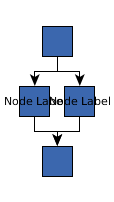 false | 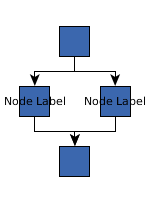 true |
public boolean isIntegratedEdgeLabelingEnabled()
labeling algorithm will be
overwritten and when disabling it, any currently specified labeling algorithm will be disabled via property
CanonicMultiStageLayouter.setLabelLayouterEnabled(boolean). Therefore, it is recommended to only use this convenience property
instead of manually changing the mentioned other properties.true if edge labels should be placed, false otherwisesetIntegratedEdgeLabelingEnabled(boolean)public void setIntegratedEdgeLabelingEnabled(boolean enabled)
labeling algorithm will be
overwritten and when disabling it, any currently specified labeling algorithm will be disabled via property
CanonicMultiStageLayouter.setLabelLayouterEnabled(boolean). Therefore, it is recommended to only use this convenience property
instead of manually changing the mentioned other properties.enabled - true if edge labels should be placed, false otherwise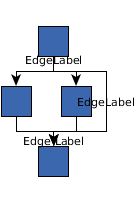 false | 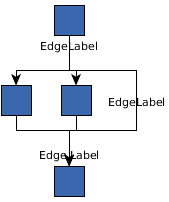 true |
public double getVerticalAlignment()
0 means that nodes are top-aligned0.5 means that nodes are center-aligned1 means that nodes are bottom-aligned
[0,1] will be matched with the nearest interval end.[0,1]setVerticalAlignment(double)public void setVerticalAlignment(double verticalAlignment)
0 means that nodes are top-aligned0.5 means that nodes are center-aligned1 means that nodes are bottom-aligned
[0,1] will be matched with the nearest interval end.verticalAlignment - the vertical alignment ratio from interval [0,1] Top vertical alignment ( 0) |  Centered vertical alignment ( 0.5) |  Bottom vertical alignment ( 1) |
public void setGeneralGraphHandlingEnabled(boolean enabled)
General graphs are required to be transformed before being laid out (by adding or removing some edges) such that
they satisfy the criteria of a series-parallel graph. After the layout, the graph will be restored and the
initial edges which weren't included in the series-parallel graph are routed by a separate
edge routing algorithm. Furthermore, the labels of these
edges are placed by a customizable edge labeling
algorithm.
enabled - true if general graphs should be handled, false otherwisepublic boolean isGeneralGraphHandlingEnabled()
General graphs are required to be transformed before being laid out (by adding or removing some edges) such that
they satisfy the criteria of a series-parallel graph. After the layout, the graph will be restored and the
initial edges which weren't included in the series-parallel graph are routed by a separate
edge routing algorithm. Furthermore, the labels of these
edges are placed by a customizable edge labeling
algorithm.
true if general graphs should be handled, false otherwisesetGeneralGraphHandlingEnabled(boolean)public Layouter getNonSeriesParallelEdgeRouter()
selection key is set.setNonSeriesParallelEdgeRouter(Layouter),
setGeneralGraphHandlingEnabled(boolean),
setNonSeriesParallelEdgesDpKey(Object)public void setNonSeriesParallelEdgeRouter(Layouter nonSeriesParallelEdgeRouter)
selection key is set.EdgeRouternonSeriesParallelEdgeRouter - the edge routing algorithm applied to the non-series-parallel edges
java.lang.IllegalArgumentException - if null is specifiedsetGeneralGraphHandlingEnabled(boolean),
setNonSeriesParallelEdgesDpKey(Object)public java.lang.Object getNonSeriesParallelEdgesDpKey()
DataProvider that is used for marking non-series-parallel edges.
This key is used for determining the edges that are not part of the series-parallel structure in a general graph,
such that the specified non-series-parallel edge router only routes marked edges.
DataProvider using the
specified key.setNonSeriesParallelEdgesDpKey(Object),
setGeneralGraphHandlingEnabled(boolean),
setNonSeriesParallelEdgeRouter(Layouter)public void setNonSeriesParallelEdgesDpKey(java.lang.Object nonSeriesParallelSelectionKey)
DataProvider that is used for marking non-series-parallel edges.
This key is used for determining the edges that are not part of the series-parallel structure in a general graph,
such that the specified non-series-parallel edge router only routes marked edges.
DataProvider using the
specified key.Layouter.SELECTED_EDGESnonSeriesParallelSelectionKey - the selection key
java.lang.IllegalArgumentException - if the given key is set to nullsetGeneralGraphHandlingEnabled(boolean),
setNonSeriesParallelEdgeRouter(Layouter)public Layouter getNonSeriesParallelEdgeLabelingAlgorithm()
edge label selection key to determine which
edge labels it should place. Otherwise, the labeling algorithm might place all
labels, including those that belong to actual series-parallel edges.setGeneralGraphHandlingEnabled(boolean),
setNonSeriesParallelEdgeLabelSelectionKey(Object),
setNonSeriesParallelEdgeLabelingAlgorithm(Layouter)public void setNonSeriesParallelEdgeLabelingAlgorithm(Layouter nonSeriesParallelEdgeLabelingAlgorithm)
edge label selection key to determine which
edge labels it should place. Otherwise, the labeling algorithm might place all
labels, including those that belong to actual series-parallel edges.SALabelingnonSeriesParallelEdgeLabelingAlgorithm - the labeling algorithm used for edge labels of non-series-parallel edgessetGeneralGraphHandlingEnabled(boolean),
setNonSeriesParallelEdgeLabelSelectionKey(Object)public java.lang.Object getNonSeriesParallelEdgeLabelSelectionKey()
DataProvider that is used by the
non-series-parallel edge labeling algorithm to determine
which edge labels it should place.
During the layout, a DataProvider with this key will be registered with the graph. It will
mark all EdgeLabelLayouts that belong to non-series-parallel edges.
A specified custom non-series-parallel edge labeling algorithm needs to obey this selection.
If using SALabeling as labeling algorithm, set this key as value of
property AbstractLabelingAlgorithm.setSelection(Object).
The labeling algorithm set as default is already configured such that it uses the correct selection key.
non-series-parallel edge
labeling algorithm but no edge label selection key, then the labeling algorithm might place all
labels, including those that belong to actual series-parallel edges.DataProvider keysetNonSeriesParallelEdgeLabelSelectionKey(Object),
setNonSeriesParallelEdgeLabelingAlgorithm(Layouter)public void setNonSeriesParallelEdgeLabelSelectionKey(java.lang.Object nonSeriesParallelEdgeLabelSelectionKey)
DataProvider that is used by the
non-series-parallel edge labeling algorithm to determine
which edge labels it should place.
During the layout, a DataProvider with this key will be registered with the graph. It will
mark all EdgeLabelLayouts that belong to non-series-parallel edges.
A specified custom non-series-parallel edge labeling algorithm needs to obey this selection.
If using SALabeling as labeling algorithm, set this key as value of
property AbstractLabelingAlgorithm.setSelection(Object).
The labeling algorithm set as default is already configured such that it uses the correct selection key.
non-series-parallel edge
labeling algorithm but no edge label selection key, then the labeling algorithm might place all
labels, including those that belong to actual series-parallel edges.NON_SERIES_PARALLEL_EDGE_LABELS_DPKEYnonSeriesParallelEdgeLabelSelectionKey - the non-series-parallel edge label selection DataProvider keysetNonSeriesParallelEdgeLabelingAlgorithm(Layouter)public PortAssignment getDefaultPortAssignment()
PortAssignment used for those nodes that do not have their own specific instance.
A PortAssignment instance is defined using a DataProvider registered with the graph with key
PORT_ASSIGNMENT_DPKEY.
setDefaultPortAssignment(PortAssignment)public void setDefaultPortAssignment(PortAssignment defaultPortAssignment)
PortAssignment used for those nodes that do not have their own specific instance.
A PortAssignment instance is defined using a DataProvider registered with the graph with key
PORT_ASSIGNMENT_DPKEY.
DefaultPortAssignment. All ports are
distributed on the borders of the nodes.defaultPortAssignment - the port assignment
java.lang.IllegalArgumentException - if null is specifiedpublic java.util.Comparator getDefaultOutEdgeComparator()
Comparator used for sorting the outgoing edges incident to nodes that do not have a
specific Comparator.
Such a comparator is defined using a DataProvider registered with the graph with key
OUT_EDGE_COMPARATOR_DPKEY.
null.Comparator for outgoing edgessetDefaultOutEdgeComparator(Comparator)public void setDefaultOutEdgeComparator(java.util.Comparator defaultOutEdgeComparator)
Comparator used for sorting the outgoing edges incident to nodes that do not have a
specific Comparator.
Such a comparator is defined using a DataProvider registered with the graph with key
OUT_EDGE_COMPARATOR_DPKEY.
null.DefaultOutEdgeComparator. The order of the edges is used along with a special
PortConstraint and edge group handling.defaultOutEdgeComparator - the default Comparator for outgoing edgespublic byte getRoutingStyle()
setGeneralGraphHandlingEnabled(boolean) is enabled.public void setRoutingStyle(byte routingStyle)
setGeneralGraphHandlingEnabled(boolean) is enabled.ROUTING_STYLE_ORTHOGONALroutingStyle - the routing style for the edgespublic double getMinimumPolylineSegmentLength()
routing style is
ROUTING_STYLE_POLYLINE.setMinimumPolylineSegmentLength(double),
setMinimumSlope(double),
setRoutingStyle(byte),
ROUTING_STYLE_POLYLINEpublic void setMinimumPolylineSegmentLength(double minimumPolylineSegmentLength)
routing style is
ROUTING_STYLE_POLYLINE.minimumPolylineSegmentLength - the given minimum vertical distance
java.lang.IllegalArgumentException - if the specified length is smaller than 0setMinimumSlope(double),
setRoutingStyle(byte),
ROUTING_STYLE_POLYLINE 30 |  60 |
public double getMinimumSlope()
routing style is
ROUTING_STYLE_POLYLINE.setMinimumSlope(double),
setMinimumPolylineSegmentLength(double),
setRoutingStyle(byte),
ROUTING_STYLE_POLYLINEpublic void setMinimumSlope(double minimumSlope)
routing style is
ROUTING_STYLE_POLYLINE.minimumSlope - the minimum slope for a non-orthogonal segment
java.lang.IllegalArgumentException - if the specified slope is smaller than 0setMinimumPolylineSegmentLength(double),
setRoutingStyle(byte),
ROUTING_STYLE_POLYLINE 0.25 |  1.5 |
public double getPreferredOctilinearSegmentLength()
routing style is
ROUTING_STYLE_OCTILINEAR.setPreferredOctilinearSegmentLength(double),
setRoutingStyle(byte),
ROUTING_STYLE_OCTILINEARpublic void setPreferredOctilinearSegmentLength(double preferredOctilinearSegmentLength)
routing style is
ROUTING_STYLE_OCTILINEAR.preferredOctilinearSegmentLength - the preferred length for non-orthogonal segments in octilinear edge routes
java.lang.IllegalArgumentException - if the specified length is smaller than 0setRoutingStyle(byte),
ROUTING_STYLE_OCTILINEAR 10 |  20 |
public EdgeLayoutDescriptor getDefaultEdgeLayoutDescriptor()
EdgeLayoutDescriptor instance used for all those edges that do not have a specific layout
descriptor assigned.
EdgeLayoutDescriptor instancesetDefaultEdgeLayoutDescriptor(EdgeLayoutDescriptor),
EDGE_LAYOUT_DESCRIPTOR_DPKEYpublic void setDefaultEdgeLayoutDescriptor(EdgeLayoutDescriptor descriptor)
EdgeLayoutDescriptor instance used for all those edges that do not have a specific layout
descriptor assigned.
EdgeLayoutDescriptordescriptor - the current EdgeLayoutDescriptor instance
java.lang.IllegalArgumentException - if the specified EdgeLayoutDescriptor is nullEDGE_LAYOUT_DESCRIPTOR_DPKEYpublic double getMinimumNodeToNodeDistance()
setMinimumNodeToNodeDistance(double)public void setMinimumNodeToNodeDistance(double minimumNodeToNodeDistance)
public double getMinimumNodeToEdgeDistance()
setMinimumNodeToEdgeDistance(double)public void setMinimumNodeToEdgeDistance(double minimumNodeToEdgeDistance)
public double getMinimumEdgeToEdgeDistance()
setMinimumEdgeToEdgeDistance(double)public void setMinimumEdgeToEdgeDistance(double minimumEdgeToEdgeDistance)
public void setFromSketchModeEnabled(boolean fromSketchModeEnabled)
comparators will be ignored if From Sketch mode
is enabled.fromSketchModeEnabled - true if input coordinates are considered, false otherwisepublic boolean isFromSketchModeEnabled()
comparators will be ignored if From Sketch mode
is enabled.true if input coordinates are considered, false otherwisepublic void setComponentLayouterEnabled(boolean enabled)
LayoutStage used for arranging the components of the graph is activated.
setComponentLayouterEnabled in class CanonicMultiStageLayouterSeriesParallelLayouter can only handle single components. Disabling
ComponentLayouter will lead to errors during execution.enabled - true if the stage that arranges the graph components is activated,
false otherwiseCanonicMultiStageLayouter.isComponentLayouterEnabled(),
CanonicMultiStageLayouter.setComponentLayouter(LayoutStage),
ComponentLayouterpublic void setSelfLoopLayouterEnabled(boolean enabled)
LayoutStage used for routing self-loops is activated.
setSelfLoopLayouterEnabled in class CanonicMultiStageLayouterSeriesParallelLayouter cannot handle self-loops. Disabling SelfLoopLayouter
will lead to errors during execution.enabled - true if the stage responsible for routing self-loops is activated, false otherwiseCanonicMultiStageLayouter.isSelfLoopLayouterEnabled(),
CanonicMultiStageLayouter.setSelfLoopLayouter(LayoutStage),
SelfLoopLayouter
|
© Copyright 2000-2025, yWorks GmbH. All rights reserved. |
||||||||
| PREV CLASS NEXT CLASS | FRAMES NO FRAMES | ||||||||
| SUMMARY: NESTED | FIELD | CONSTR | METHOD | DETAIL: FIELD | CONSTR | METHOD | ||||||||